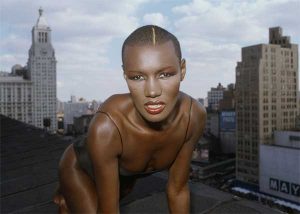Here’s Grace Jones, still Grace, one and only Grace, the original, the body, the desire, the face, look at her reaction, look at our reaction. She is Grace, hard to pin down, she no longer exists, she’s right here, immortal and startling, invisible and relentless, arriving from someplace and some time of her own choosing, some other world, from her own place in history, thirty years or so since she started singing songs and making records, as old as she is, as young as she is, as ready as she is for when she begins again to be Grace. No sooner has she finished being Grace than she begins all over again, astonished by what she discovers so that she might astonish us, and vanish.
It is early evening. She is in a room with no windows that is underground in the east end of a city that is one of her homes. There soon seems to be no outside to this building. She has made the world disappear for a while. She has asked me to join her. She has a few things she wants to say. She has finished a new album, her first for some time, and one that amongst other things takes a tour through time, and the way it holds us in place even as it lets us go, the way it connects us and separates us. It sounds like an album she could have made before, when she was younger, striding from country to country to the magazine to pose to club to city to city to the 12-inch mix to stage to television to the big screen to infamy and beyond, and an album she could only have made now, or at some point in the future. It’s the magic of a younger Grace mixed with the magic of a later Grace. It is called Hurricane because “it’s heavy and it’s powerful and it’s right in your face.” She’s produced it with Ivor Guest and Ant Genn, it’s taken all the time in the world to make, and no time at all, it features contributions from Tricky, Brian Eno, Sly and Robbie, young guitarist Leo Ross, and percussionist Tony Allan (Fela Kuti/Good, the Band and the Queen), “we were all part of the same dream, a dream that becomes a reality that becomes a dream,” and it reports on and illuminates and slips through her history and her future, her name, and her genius.
It was set to be released in 2006, which would have been some kind of anniversary, and then it was nearly ready for 2007, which would have also been thirty years since something or other, and now, she’s sure, it’s to be released in 2008. “I like the 8. It’s two complete circles, which I love.”
You wouldn’t know it now, but when she started singing professionally, in a studio, she froze, she trembled, she couldn’t make a noise, she hadn’t found her voice, she didn’t know if she had a voice. She tried to sing like other singers, because she was told to, but couldn’t sound like other singers. “I was very shy. But I thought, I really want to do this. I must do this. I sang under the table so the studio people couldn’t see me. It was a new birth for me.” When she managed to sing, there was Grace, lost soul, active mind, marching forward, dancing up a storm, pronouncing words, generating rhythm, and manipulating melody in a world of her own. Her first album (1977) as an exotic ominous model with traumatized past turned demented disco diva was called Portfolio. Strangely built, powerful and motivated, flamboyantly uninhibited, her deep, tender voice exquisitely penetrating the essence of pain and pleasure, she became known as the Queen of the Gay Discos.
Portfolio was released after she had become an early 1970s top international model, gracing the covers of Vogue and Elle. She became a model after briefly studying theatre at Syracuse University at 17, then moving to Philadelphia, then New York, where, they say, she shaved her head, became a nude model for student painters, and tried go-go dancing. She auditioned for the then fashionable black exploitation films. “I always came second. Always the callbacks, the callbacks, almost making it, but always not quite. There was a lot of competition and my face did not belong. My face was special but it was very difficult to get work.”
She kept moving. “Some people need to feel secure before they move on. I just kept moving. I kept following the yellow brick road. I just put my thumb out.” As she fitted into the charged outside night and island intoxication of New York, they say, she was photographed repeatedly by Andy Warhol, who no doubt noted among other things that the air around her was always electric, her eyes were threatening and her skin was dazzling. Together they went to Studio 54, wearing each other, chasing sensation, seeing how the business of money and sex is mixed up with something primitive and deep, passing each other secrets about how to behave in public, and how to misbehave in private. “I was very wild and childish and spoilt. I wanted things and I wanted them now. I had this attitude that nothing was going to stop me.” She gets to Paris via Luxembourg and hitchhiking. She makes herself known.
Before all this, she was born in Spanish Town, Jamaica, to the Reverend Robert Jones and Majorie Jones. Christian was the name of her twin brother. The family religion was Pentecostal. It was an extremely strict upbringing. Passions of a certain sort were significantly restricted. She was wed to and reacted violently against the mysterious comforts and fixed rituals of the Church. She had a childhood, she says, that was not a childhood. She was infected by something macabre in the Caribbean. You could hear the drums in the distance. The family moved to Syracuse when she was 13. In high school, she was called “socially sick.” She remembers clearly the satisfaction of being wicked. The guilt was half triumph. She soaked everything up, and got ready for action. She discovered the attractions and seductions of a world previously denied her. She made up for lost time: she embarked on a fantastic journey through space, time, and sexuality.
She found her voice, and her face. The increasingly uncanny albums that followed Portfolio were called Fame, Muse, Warm Leatherette, and Nightclubbing. To some extent, they all examined sexual experience, distraught love, and ecstatic suffering. One music paper said that the icy, spicy and lascivious Nightclubbing (1981), which combined songs written by Bowie, Iggy, and Sting with the fluid, feline Sly and Robbie Jamagical rhythm section, ‘changed the face of dance music.’
Keith Haring painted her scandalous speed and skin. Chris Blackwell sought her out and sorted out a sound that was her head and heart in noble, crystalline sonic form.
Helmut Newton photographed her eyes, breath, and bones. He said you’ve got the greatest legs. He adored her ankles.
Jean-Paul Goude deconstructed her pride, mind, and body, exposed the puzzle, raised her eyebrows, and adored the woman.
She ate cars and slapped chat show hosts and leaped mountains and fought demons and conquered space and cut through the 80s and walked the talk and read our minds and clashed semi-naked with James Bond and had erotic, spiritual, and marital ups and downs.
“I guess I looked pretty hot and I was strong and I didn’t give a shit really.”
Albums that followed Nightclubbing in the 1980s: Living My Life, Island Life, Slave to the Rhythm (1995) – a vivid and feverish electro-musical about the life and mystique of Grace Jones starring Grace Jones – Bulletproof Heart and Inside Story.
Albums in the 1990s: –
Other people are with us because she has decided what she wants to do, and she wants to film a conversation that we are about to have so that it is fixed in time, which to some extent means setting it outside time. She is up to something, which is always a good sign for those of us who have watched Grace Jones since the beginning of what seems like time, seeing and hearing her at work and at play, photographed and rearranged, created and recreated, planning performances, instigating various surreal jolts, a series of energy storms, singing fractured pressurized soul songs about the risk behind every decision we make, about the way things really are, about the strange turns life takes, finding new ways to move through the world, opening herself up to the different and the foreign both around and inside us.
She is writing a story and calling it “Grace Jones.” She is naming herself so that we know her name, which might help us remember who she is and who she becomes in relation to our own lives. She’s writing about her life as a string of events and adventures, men and woman, lives and deaths, masks and memories, imaginary places and states of mind, and other adventures and rites of passage she has passed through that make up a kind of mystery story about identity and the past. We never quite get enough information, but we get enough to make us want to keep looking, and listening, for clues about who she really is, and what she’s got on her mind.
Time stops when she says so. The world is what she wants it to be. She is making up a series of possible Grace Jones. Hero and villain; lover and thinker; singer and dreamer; daughter and mother; object and nomad; mystic and celebrity; disco and punk; New York and Jamaica; child and alien; dead and alive; actress and model; lost and found; animal and mineral; man and woman; savage and sublime; ancient and modern; spirit and machine; romantic and comedian; clear and opaque; loner and leader; fable and ancestor; innocent and damned; healer and hedonist; sister and sensualist; Africa and Europe; concrete and abstract; criminal and illusionist; star and experiment; spiky and lush; restless and settled; reflective and rowdy; irresponsible and generous; lawless and pious; fact and fiction; temperamental and intimate; mute and noisy; precise and approximate; stage and screen; beginning and end; Grace and Grace.
She is making herself up so that in this underground room there are at least two of her, the real and the reflection, the truth and the image, the flesh and blood, and the mirror. A shadow turns into form. The form throws a shadow you would recognize anywhere. Surrounded by a mountain of expensive cosmetics, she is searching for the right combination of powder, color, texture, moisture, gloss, and shimmer so that she might reproduce the fact that we can all see is Grace and nothing but Grace, replacing the absence with presence, or the private with the public, or a memory with a moment. I watch as her face becomes Grace, the Grace that has emerged, from the Grace that withdraws. The Grace we think we know and the Grace she might coincide in space and time. Here’s Grace, using lipstick and blusher to solve the mystery of herself. Grace, inventing herself in front of our eyes. Grace, here.
She is assuming an identity, concealing something of herself as she reveals something of herself. She paints herself, fills herself in, creates an impression of an expression, and becomes Grace, little changed from when we would first see her fierce, fast face ghosting across the dissolving surfaces of the 1970s. She was there, and now she is here, perhaps to explain where she has been, and where she is going. They say she is sixty years old, but I don’t believe them. She doesn’t believe it herself, because she doesn’t quite believe anything. They say she has been looking out of a window at a desert, or a city, or the ocean, or the stars, or the first golden light of the morning, or a picture of herself, for hundreds of years, which may be nearer the truth. She’s being born in front of me. There’s a look in her eyes that makes it clear she wants something to happen. She wants to find out who she is and where she’s come from. She wants to sing songs about who she is and where she’s come from. Supernaturally alert songs that are as fantastic as the world and that stretch around her in three dimensions.
She is hungry. She eats Oysters, with relish. Here’s Grace, asking for the hot chili sauce to drop into her oyster. She is thirsty. She drinks champagne, red wine, and coffee. The man from her new record label Wall of Sound admits that this is not something he has previously had to do for any of his acts, fetch champagne and oysters, and a voluptuous, not cheap red wine that would satisfy the most discriminating of palates.
It is nighttime. Under the stars, Grace needs to get changed, to finish the transformation from before to after, from solid to liquid. She selects something from the huge suitcase filled with clothing and costume that follows her around the world as she wanders from moment to moment, so that whatever the occasion, whatever the time of day, whoever the company, wherever the room, the open space, she has at her disposal the right combination of shape, color, and texture. She slips into the appropriate glamorous material and places on her head rippling layers of gold that cover her head religiously and provocatively, brilliant gold that flows over her shoulders. She looks ready to host some ancient occult ceremony that could lead to the disappearance of the sky and the appearance of a spaceship. She dresses up because she’s happy to play the role of entertainment goddess, because she is about to perform because she needs the world to know, or the few people who are with her in this underground space and those that might see the film of what happens, that she is who she is. Grace, eternal.







